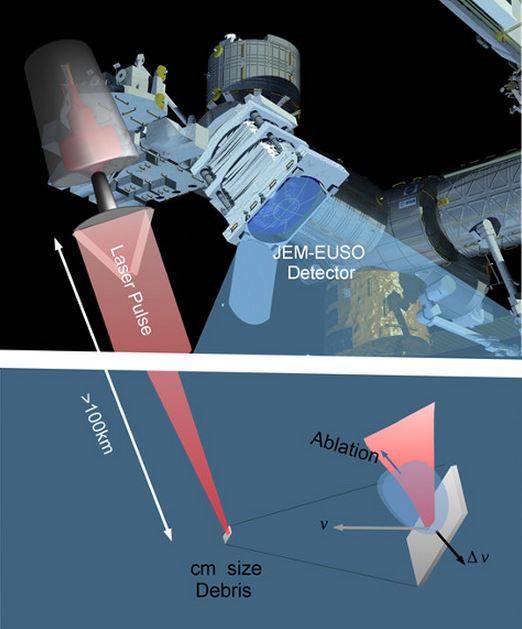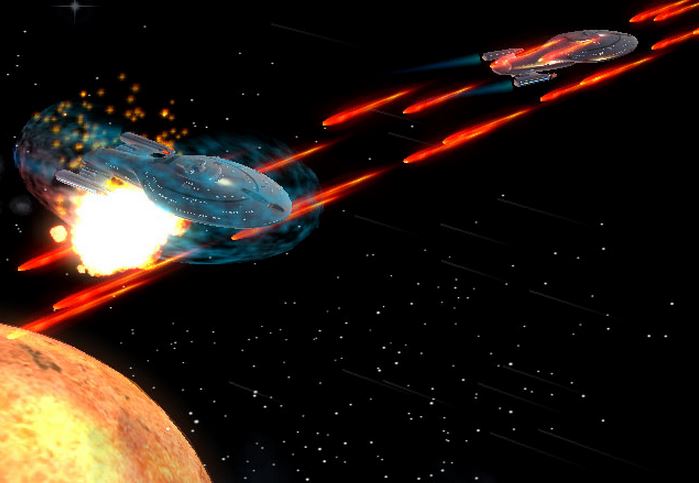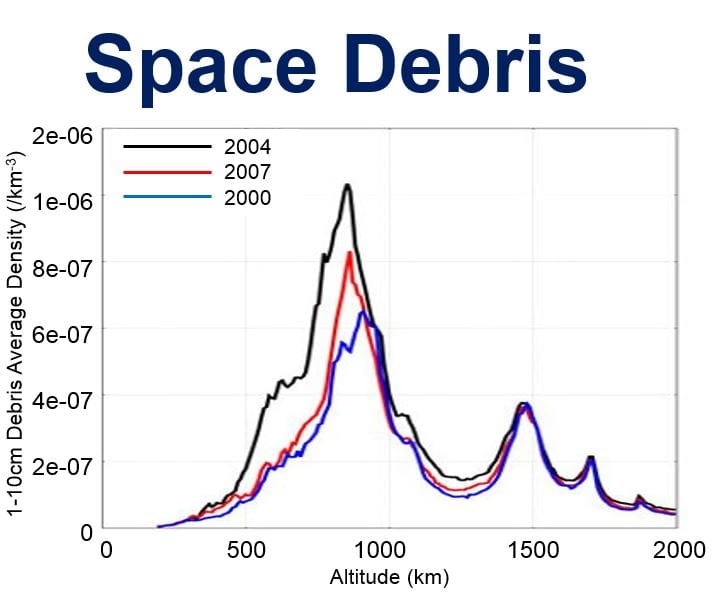Space technology may soon reach its first weapons milestone if a proposal to fit a laser gun on the International Space Station to protect it from orbiting debris, also known as ‘space junk’, goes ahead.
An international team of researchers from the Riken Institute, Japan; the Istituto Nazionale di Fisica Nucleare, Italy; the Ecole Polytechnique, France; and APC-CNRS Paris7 University, France, detailed their proposal in the journal Acta Astronautica.
According to Russian, US and European space agencies, more than 3,000 tons of space junk currently orbits our planet.
Space junk consists of old satellites, rocket bodies and parts, and smaller fragments produced when pieces of debris collide.

An illustration of the proposed system based on the EUSO telescope and a CAN laser system. (Image: riken.jp)
It is not that easy to just collect all the debris up there and send it somewhere safe. There are pieces all over the place and at hundreds of different altitudes. We do not have the technology to capture even a fraction of them.
The International Space Station (ISS) is at serious risk of a major collision which could cause severe damage and threaten the lives the of human astronauts on board.
Toshikazu Ebisuzakia, who works at the Riken Institute (理研), and colleagues propose that the Extreme Universe Space Observatory (EUSO) telescope, which is currently attached to the ISS, be turned into a space-debris-seeking device, specifically to spot space junk that may pose a threat to the space station.
As soon as any threatening debris is spotted, a laser beam gun would shoot at it until it either fell into Earth’s atmosphere and burnt up or moved out of orbit into space.
The growing problem of space junk
Ever since the first satellite was launched into space from the then Soviet Union in 1957 – Sputnik – by the R-7 ICBM rocket, thousands have followed.
As more and more satellites went into orbit, the amount of space junk orbiting our planet has increased. There is so much space debris up there now that no functioning orbiting satellite today is safe. Several have been either damaged or destroyed by flying debris.

Would this be the first step towards the ultra-sophisticated space weapons of the future?
Researchers have put forward a number of proposals to address the space debris problem, from using powerful gas blasts to deflect the floating bodies, to using nets to catch and move them somewhere else.
“Our proposal is radically different from the more conventional approach that is ground based, and we believe it is a more manageable approach that will be accurate, fast, and cheap.”
“We may finally have a way to stop the headache of rapidly growing space debris that endangers space activities. We believe that this dedicated system could remove most of the centimeter-sized debris within five years of operation.”
 Graph showing how year by year space debris is growing. (Image: riken.jp)
Graph showing how year by year space debris is growing. (Image: riken.jp)
Start off with a small trial
In this latest proposal, the scientists suggest starting off with a laser shooter fitted to one of the smaller telescopes on board the space station. If that works out well, then a larger one could be installed.
Ideally, a three-metre telescope should be fitted with a laser built out of 10,000 fibres, the authors say. The weapon would be able to fire at space debris from a distance of 100 kilometres.
The authors wrote in an Abstract in the journal:
“We present here designs for a staged implementation of an orbiting debris remediation system comprised of a super-wide field-of-view telescope (EUSO) and a novel high efficiency fibre-based laser system.”
Reference: Toshikazu Ebisuzaki, Satoshi Wada, Yoshiyuki Takizawa, Marco Casolino, Mario E. Bertaina, Mark N. Quinn, Etienne Parizot, Toshiki Tajima, Philippe Gorodetzky, Rémi Soulard, Gérard Mourou and Lech Wiktor Piotrowski. “Demonstration designs for the remediation of space debris from the International Space Station.” Acta Astronautica. July-August 2015. DOI: 10.1016/j.actaastro.2015.03.004.
Video – Space debris
This NASA animation shows the distribution and movement of man-made objects orbiting our planet.
